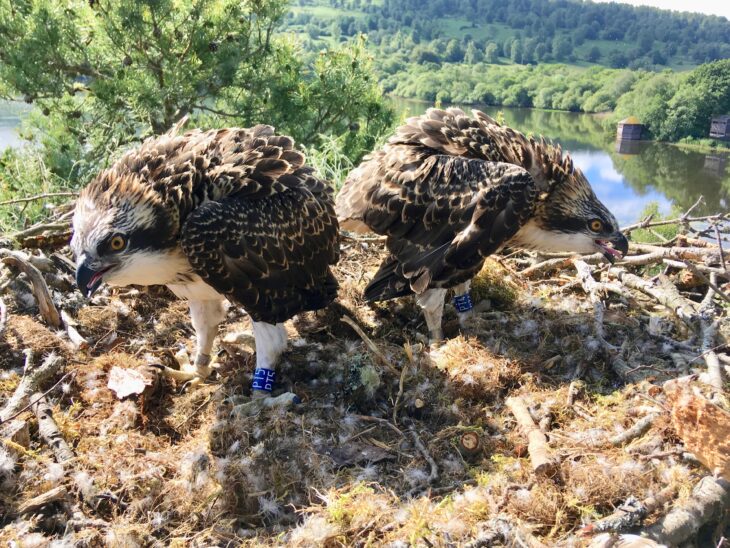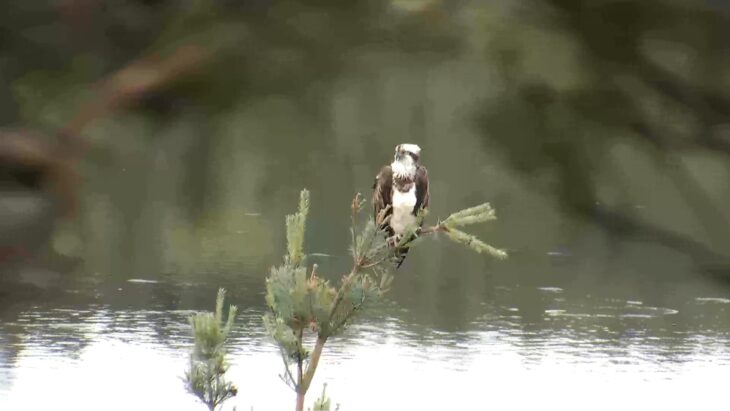Meet PT4 and PT5
What a cracker of a day for the annual ringing of the young osprey chicks!
The team at Lowes could not have asked for better weather; calm, warm and not a breath of wind, perfect for the tricky job of ascending the tree by local licensed and experienced raptor ringer Keith Brockie. The young birds even had an early feed – or ‘breakfish’ – ready for the day ahead.
Keith has decades of experience and the chicks were safe in his hands. Once he had ascended the tree the ringing process itself took only a mere 12 minutes! Ringing on the nest not only speeds up the process, but minimises the disturbance to both chicks and adults.
The chicks’ natural instinct is to play dead as soon as they hear their parents’ alarm calling, which makes handling the birds much easier. The chicks are further calmed by placing a piece of dark material – in this case Keith’s ringing gillet – over the birds. All that is required to secure the ring is to gently coax out each leg.
In Scotland ospreys are ringed with a coloured ‘Darvic’ ring on their left leg, whereas ospreys from England and Wales receive their coloured ring on their right leg. A smaller metal BTO (British Trust for Ornithology) ring is then attached to the other leg.
This code is used to register the bird into a UK-wide database. Along with the ‘Darvic’ code it is unique to each bird. This year our chicks have been ringed as Blue PT4 and Blue PT5.
The wingspan of each bird was also recorded, with PT4 measuring 390mm and PT5 coming in at 380mm.
Sexing the birds is always based on a ringer’s judgement and experience, however one indicator that is fairly accurate is observing the fit of the ring. Female birds have much thicker leg bones at the time of ringing than the males. Keith’s observations this year indicate that we potentially have two young males on the nest.

This year Dyfi Osprey Centre and Aberystwyth University are gathering material to profile the genetic diversity of Britain’s osprey population. Our young ospreys donated a few of their smallest feathers for genetic testing, and it will be interesting to see if indeed they do turn out to be two males. You can read more about the planned genetic testing in a series of blogs here.
Why is it important to ring ospreys?
Ringing allows us to build a more comprehensive picture of the behaviour, migration, dispersal and breeding population of each species. Long term patterns in bird populations, particularly as climate change begins to have an effect, is of critical importance.
And with more amateur birdwatchers accessing high powered telescopes and cameras it is becoming easier to sight and positively identify ringed birds. The Roy Dennis Wildlife Foundation has some useful information about both identifying and reporting osprey rings on its website. You can read more about ringing here.

Throughout the ringing operation both LM12 and LF15 flew tight to the nest, keeping a close eye on the proceedings. After seeing off a few intruding ospreys which were drawn in by their calling, our pair subsequently settled onto some of their favourite ‘guard’ perches. It won’t be long before LM12 brings in another feed, but for now, all is calm on the nest once again.
What’s next?
The next milestone in these young birds’ journeys will be fledging, which we would expect to happen anywhere in the next 10 days to 2 weeks. If you’ve been watching the Loch of the Lowes webcam you’ll probably have seen them stretching their wings, furiously flapping to build up flight muscles and even beginning to get some lift – also known as ‘helicoptering’!
While it can make for some nervy viewing, it is what these birds are designed to do and it won’t be long before they are learning all there is to know about flying and hunting!
Sara ‘Raz’ Rasmussen
Perthshire Ranger
Help protect Scotland’s wildlife
Our work to save Scotland’s wildlife is made possible thanks to the generosity of our members and supporters.
Join today from just £3 a month to help protect the species you love.
Preface
What a cracker of a day for the annual ringing of the young osprey chicks! The team at Lowes could not have asked for better weather; calm, warm and not …
